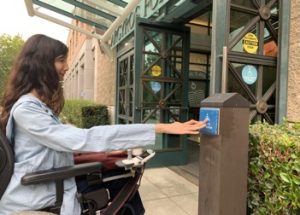
*******************************************
Three of Chapman University’s historic buildings were recently renovated with the goal of being more accessible to people with disabilities. These renovations may have eliminated some physical barriers to access, but disabled students say there is more left to do.
And physical barriers are not the only obstacles that people with disabilities are facing on campus.
“There’s kind of two layers: There’s the technical aspects of making something more accessible but then there’s also changing the mindset of the population,” said Jason McAlexander, director of Disability Services.

Lara Ameen is a graduate student pursuing her doctorate in education with an emphasis in disability studies. Ameen has Cerebral Palsy and Scoliosis. She still experiences barriers when it comes to physical access on campus.
“I wish the campus shuttles could be a bit bigger and accommodate two or three wheelchairs per shuttle. The last time I was on a shuttle, it could usually only hold me and my wheelchair and barely accommodate two,” Ameen said. “This makes it harder if more wheelchair users or people with larger mobility devices need to be somewhere on time.”
She also noted that she would like to see, “push buttons for every entryway [and] door on campus, even the bathroom doors.”
Issues of physical access are not the only barriers that Ameen sees on campus. Ameen said the biggest barrier to access is ableism.
Ableism is the harmful way that society acts towards people with disabilities. To simplify, it means that our society is built to cater to the wants and needs of people without disabilities, often leaving people with disabilities behind.
“Many people aren’t even aware of disability access issues to begin with,” said Ameen.

Freshman psychology major Helen Lee, who uses a wheelchair, said that there is more that people can do to promote accessibility and inclusion, starting with listening to the voices of people with disabilities.
“If you don’t have any disabilities, it would be hard for you to know what it is like living with a disability and how even the smallest things can be big barriers,” Lee said. “When you attentively listen to the stories of disabled people, you’ll begin to notice the parts of this campus that need improvements.”
Two examples from Lee:
One, she cannot get around inside the bookstore. The aisles are simply too narrow for easy wheelchair access. The second being the push-button issue, which Ameen brought up.
“When there is no push-button swing door opener beside a door or when the button doesn’t work, it’s very hard for me to enter the building or the room,” said Lee.
Ameen and Lee are not the only ones who see a demand for awareness on campus. McAlexander sees increased awareness and inclusivity as necessary steps to move toward a more accessible campus, but that starts with asking and listening to the disabled community.
“Don’t touch visibly disabled people without consent, always ask first. Sometimes we may look like we’re struggling, but don’t need help and other times we would appreciate the help. Always ask first,” said Ameen.
Many people with disabilities have to self-advocate for themselves, meaning they must ask for the accommodations that they require. Increased awareness among faculty and students would also take some pressure off of students with disabilities.
“There’s a lot of emotional labor involved in self-advocacy,” said Jana Remy, who serves as the co-chair of the Advisory Group on Disability and Accessibility for the Chapman Diversity Project.

The Advisory Group is an open group made up of faculty and students.
“It allows people to bring concerns that they have up for discussion,” said Remy. “We’ve discussed a whole gamut, whether a personal interaction where somebody felt that they were treated differently because they had a disability, or a personal interaction where somebody identified a barrier like access to a building.”
A lack of awareness on campus often leads to events and plans being inaccessible to people with disabilities.
With so many students and so much diversity among them, the needs for students with disabilities can vary from one another. A possible solution to this is an approach called Universal Design of Construction, broken down into two parts: design and instruction.
Universal Design aims to design accessible physical spaces so the needs of people with disabilities would be taken into consideration before designing a space, rather than altering a pre-existing space to accommodate for their individual needs.
Universal Instruction aims to create a curriculum that works for all types of learners instead of expecting students to ask for individual accommodations to the pre-existing curriculum. This would mean designing new spaces and curriculum rather than changing old ones.
“The hope is to move toward Universal Design. It’s beginning to become a part of the larger conversation,” said Remy.

Remy and her advisory group have gone on tours of multiple classrooms at Chapman to implement Universal Design in physical spaces. The members of the group identified some potential barriers to students with physical differences.
“[The] desks that are called tablet arms — the ones that are a desk and chair all in one — are not particularly comfortable to all types of bodies,” said Remy. “We’ve tried to move away from that kind of seating. Many of the desks that we have in Smith and Reeves Hall are not attached. Some are even adjustable heights.”
These renovations are a step in the right direction, but the work to create a more accessible campus is from over.
“Imagine going through your day and thinking, ‘Could this person really do everything that I do without any barriers?’ If the answer is no, something needs to be done,” said Lee. “I’m not asking anyone to ‘fix’ every flaw perfectly. Rather, I’d simply like to invite everyone to cooperate to make a better campus.”
